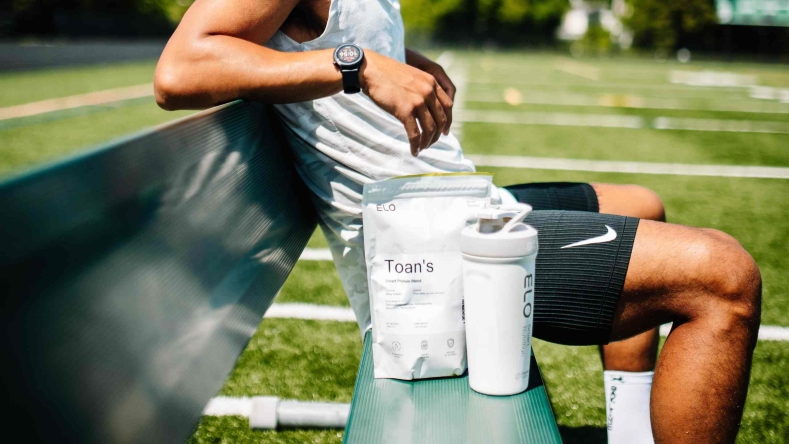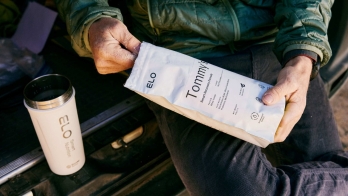How to maintain muscle mass as you age
As you age, you may start to experience a decrease in muscle mass. And while you can’t turn back the clock, there are some ways you can mitigate muscle loss and improve your health span. Here’s what you need to know about how to maintain muscle mass as you age.

As the years tick by, loss of muscle mass due to aging and subsequent health risks rise. But luckily, consistent resistance training and savvy lifestyle choices stand as your defense, putting you in the driver's seat of combating muscle loss.
Building and maintaining lean muscle is a crucial component of aging gracefully, having a better health span, and improving mobility for years to come. But are there any other benefits that come with having muscle mass, and how can you effectively develop it?
In this article, we’re turning to research for a better understanding of what muscle mass is, the importance of it, and how you can implement certain lifestyle choices to preserve its strength.
Understanding muscle mass
Muscle mass can simply be defined as the size of your muscles and the amount of muscle you have in your body. These muscles are integral for a diverse amount of bodily functions, such as facilitating movement and maintaining posture [1] [1]
There are three distinct categories of muscle:
Skeletal muscle. Skeletal muscle makes up 40% of our total body weight, and plays a crucial role in movement, posture and activity
[1]
. This muscle is a large contributor to essential bodily functions, as it helps support bones and control over voluntary movement.Smooth muscle. The smooth muscle can be found in your stomach and throughout intestines. It helps with digestion, nutrient collection, and is present in your urinary system to help rid your body of toxins
[2]
. Different to skeletal muscle, smooth muscle acts involuntarily and regulates your body’s sub systems without any thought.Cardiac muscle. The cardiac muscle serves a vital role in the heart, being primarily responsible for contracting and driving the pumping action that propels blood throughout the body
[5]
. This muscle possesses considerable strength to meet the body's metabolic requirements, and much like smooth muscle, its actions are involuntary.
Why is muscle mass important?
Muscle mass is essential for maintaining overall health and well-being, as it contributes to functional strength and quality of life. Increased muscle mass also aids in maintaining healthy body composition, reducing the risk of chronic diseases, supporting mobility and balance, and promoting independence in daily activities, especially as you age. Furthermore, studies have also found that muscle mass may help prevent injury, increase bone density, boost metabolic rate, and help maintain overall mental well-being and cognitive function [ 16 17 18 19 why muscle mass is important
How to calculate muscle mass
Your body composition can serve as a significant indicator of high versus low muscle mass and body fat levels [1].
Body fat percentage: Weigh yourself on a body fat scale and subtract this number from 100 to find your lean body mass [
8
]. Remember this number is only an estimate.Simple Muscle Weight (SMW): This is an equation that can help identify diminished muscle mass
[3]
. You can calculate your number with the following: SMW=289.2*(body weight measured - BMI)+3631
Calculating muscle mass can provide valuable insights for everyone, but it’s especially for older adults. Studies have found that the accumulation of fat is a substantial contributor to physical limitations in the elderly, resulting in heightened fat mass and diminished lean mass. Therefore, evaluation and calculation of body composition serve as valuable metrics as you age [ 10

4 factors that affect muscle mass
Research continues to show that muscle mass plays a large role in the health of older adults, as it can help improve mobility and boost longevity. Here are some factors that can influence muscle mass.
1. Not getting enough protein
Protein intake is critical in building lean muscle, providing the essential amino acids required for muscle protein synthesis. Insufficient protein intake can adversely impact muscle tissue by hampering synthesis. Therefore, consuming sufficient protein plays a pivotal role in reducing the risk of sarcopenia and significant muscle mass among older adults [4]
The amount of protein needed to build muscle varies based on factors such as age, sex, weight, and activity level, but here are some general guidelines:
Adults: 0.8 g/kg/day
People over 70: 1.14 g/kg/day
[4]
While protein requirements and consumption vary based on a range of factors, such as age and health status, research reveals that 40% of individuals over the age of 70 fail to meet the required protein intake
[6]
.
Interestingly, studies have found that people aged 70 to 79 who consumed at least 1.1 g of protein/kg/day lost 40% less lean body mass compared to those who only consumed 0.8 g protein/kg/day [ 4 ,6]
You can meet your protein intake through dietary sources (such as lean meat, dairy products, and eggs) or from supplementation options, like Elo Smart Protein

How Elo Smart Protein can help maintain muscle mass
If you are looking to get a headstart on combating age related muscle mass loss - Elo is here to help. Elo Smart Protein
Notably, this personalized blend is informed by the latest nutrition science, aligning your data with optimal wellness boosters
Elo eliminates the uncertainty surrounding your nutritional requirements. Whether your aim is to enhance peak performance or proactively maintain muscle mass, Elo stands by your side and can be a key factor in helping you age with grace. Your Smart Recovery blend is just a click away! Discover your custom blend today
2. Aging
As we grow older, muscle mass typically decreases by approximately 3% to 8% per decade after reaching 30 years of age, resulting in an annual loss of around 0.2 kg of lean weight [10] [10] [4]
While you can’t turn back the clock, you can mitigate the amount of muscle you lose through protein intake, strength training and cardiovascular activities.
3. Sarcopenia
Sarcopenia is a condition that affects your musculoskeletal system, and leads to a gradual loss of muscle strength, mass, and function. The development of sarcopenia is predominantly linked to age, but lifestyle factors (such as poor nutrition, lack of physical activity, alcohol consumption, and tobacco usage) can also play a role.
While you might not be able to fully prevent sarcopenia, you can take a few steps to slow its progression:
Focus on getting enough protein (20-35 g/meal).
Stay active and include resistance training in your exercise routine.
Get routine physicals with your healthcare provider.
4. Sedentary lifestyle
Research shows that sedentary individuals may experience a decline of 3% to 8% in muscle mass per decade, coupled with a reduction in metabolic rate and an increase in fat accumulation [10]
To combat muscle loss, experts recommend consistent resistance and aerobic training, as these have been found to enhance protein synthesis, promote muscle mass growth, and decrease the decline in muscle mass and strength associated with aging [ 6 ,7]
Furthermore, studies have shown that people who participated in 10-12 weeks of resistance and strength training saw an increase in lean weight, resting metabolic rate, muscle strength, and fat weight [ 6 ,10].
Research indicates that improvements in muscle strength among older adults can be seen with as little as one session of resistance training per week
[6]
.
Science-backed tips for how to maintain muscle mass
Experts agree that maintaining muscle is vital for your overall health and wellness. Here are the best science-backed tips for how to maintain muscle mass as you age.
Cut back on alcohol. Research indicates a correlation exists between increased alcohol consumption and an overall diminishment of muscle mass and deterioration in muscle health
[15]
.Stop smoking. A study has identified a connection between weekly smoking and decrease in muscle strength among both men and women, regardless of lifestyle variables. Undoubtedly, smoking exhibits an inverse link with skeletal muscle strength among healthy adults
[11]
.Get more sleep. As we age, attaining sufficient sleep becomes increasingly difficult. Shorter sleep durations have been linked to declines in muscle mass and impaired muscle function, which can lead to an elevated risk for falls
[14]
.Maintain a healthy weight. Research has revealed significant associations between obesity and onset of sarcopenia in later stages of life. Weight stands out as a modifiable risk factor closely linked with sarcopenia. Obesity-related factors can exacerbate sarcopenia among elderly, having profound impacts on physical disability, morbidity, and mortality [
13]
.Consider supplements. Studies have shown that
certain supplements
(like ashwagandha, turmeric, magnesium, and probiotics) can be beneficial for gaining muscle and reducing inflammation.
Summary
Comprehending muscle mass is crucial in understanding its vital role in various bodily functions. Muscle mass significantly impacts overall health, and age related declines in muscle strength and function emphasize the need for lifestyle choices to maintain muscle mass.
While there is no one-size-fits-all when it comes to muscle growth, it’s important to prioritize nutrition (especially from protein and supplements) and consistent resistance training to help counteract the risk of sarcopenia and allow you to strive for an active and healthy lifestyle.
Disclaimer: The text, images, videos, and other media on this page are provided for informational purposes only and are not intended to treat, diagnose, or replace personalized medical care.
Key takeaways
Muscle mass plays a vital role in bodily functions, such as movement and posture, and can be categorized by three categories skeletal, smooth, and cardiac muscle).
Muscle mass impacts overall health, correlating higher mass with greater strength and resilience, while reduced mass increases vulnerability.
Sarcopenia is an age related decline in muscle mass. While it’s not preventable, you can mitigate the effects through healthy lifestyle choices, getting adequate protein intake, and doing strength training exercises.
Protein intake is critical in building lean muscle, providing the essential amino acids required for muscle protein synthesis. You can meet your protein needs with dietary sources or with supplementation (like Elo Smart Protein).
You can improve muscle mass through adequate nutrition (especially from protein and supplements) and consistent resistance training.
References
Frontera, W. R., & Ochala, J. (2015). Skeletal muscle: a brief review of structure and function. Calcified tissue international, 96(3), 183–195.
https://doi.org/10.1007/s00223-014-9915-y
Hafen, B.B., & Burns, B. (2023). Physiology, Smooth Muscle. In: StatPearls. StatPearls Publishing.
Kurokawa, Y., Kurokawa, T., Fujii, M., Tanifuji, M., Nakajin, T., Sato, T., & Machida, I. (2023). Proposal for a Simple Equation for Limb Muscle Weight Calculation. Medical science monitor : international medical journal of experimental and clinical research, 29, e938606.
https://doi.org/10.12659/MSM.938606
Mithal, A., Bonjour, JP., Boonen, S. et al. (2013). Impact of nutrition on muscle mass, strength, and performance in older adults. Osteoporos Int 24, 1555–1566.
https://doi.org/10.1007/s00198-012-2236-y
Ripa, R., George, T., & Sattar, Y. (2022). Physiology, Cardiac Muscle. In StatPearls. StatPearls Publishing.
Rom, O., Kaisari, S., Aizenbud, D., & Reznick, A. Z. (2012). Lifestyle and sarcopenia-etiology, prevention, and treatment. Rambam Maimonides medical journal, 3(4), e0024.
https://doi.org/10.5041/RMMJ.10091
Ryoichi Tagawa and others, Dose–response relationship between protein intake and muscle mass increase: a systematic review and meta-analysis of randomized controlled trials, Nutrition Reviews, Volume 79, Issue 1, January 2021, Pages 66–75, https://doi.org/10.1093/nutrit/nuaa104
Smith, L. (2018). How long does it take to build muscle? Medical News Today.
https://www.medicalnewstoday.com/articles/320769
Vilaça, K. H., Carneiro, J. A., Ferriolli, E., Lima, N. K., de Paula, F. J., & Moriguti, J. C. (2014). Body composition, physical performance and muscle quality of active elderly women. Archives of gerontology and geriatrics, 59(1), 44–48.
https://doi.org/10.1016/j.archger.2014.02.004
Westcott W. L. (2012). Resistance training is medicine: effects of strength training on health. Current sports medicine reports, 11(4), 209–216.
https://doi.org/10.1249/JSR.0b013e31825dabb8
Maarten O. K., Trynke H., Jos W.R. T. (2012). The Longitudinal Relation between Smoking and Muscle Strength in Healthy Adults. Eur Addict Res 1, 18 (2): 70–75.
https://doi.org/10.1159/000333600
McPherron, A. C., Guo, T., Bond, N. D., & Gavrilova, O. (2013). Increasing muscle mass to improve metabolism. Adipocyte, 2(2), 92–98.
https://doi.org/10.4161/adip.22500
Lutski, M., Weinstein, G., Tanne, D., Goldbourt, U. (2012). Overweight, Obesity, and Late-Life Sarcopenia Among Men With Cardiovascular Disease, Israel. Prev Chronic Dis.
http://dx.doi.org/10.5888/pcd17.200167
Liyuan, F., Xing, Y., Wen, Z., Peipei, H., Li, K, Yixuan, M., Liye, J., Hairui, Y., Xiaoyu, C., Lin, H., Lu, W., Qi, G. (2019). The Relationship Between Sleep Duration, Falls, and Muscle Mass: A Cohort Study in an Elderly Chinese Population. Rejuvenation Research.
http://doi.org/10.1089/rej.2018.2102
Cui, Y., Huang, C., Momma, H., Sugiyama, S., Niu, K., & Nagatomi, R. (2019). The longitudinal association between alcohol consumption and muscle strength: A population-based prospective study. Journal of musculoskeletal & neuronal interactions, 19(3), 294–299.
https://www.ncbi.nlm.nih.gov/pmc/articles/PMC6737549/
McPherron, A. C., Guo, T., Bond, N. D., & Gavrilova, O. (2013). Increasing muscle mass to improve metabolism. Adipocyte, 2(2), 92–98.
https://doi.org/10.4161/adip.22500
Suchomel, T. J., Nimphius, S., & Stone, M. H. (2016). The Importance of Muscular Strength in Athletic Performance. Sports medicine (Auckland, N.Z.), 46(10), 1419–1449.
https://doi.org/10.1007/s40279-016-0486-0
Sutter, T., Toumi, H., Valery, A., El Hage, R., Pinti, A., & Lespessailles, E. (2019). Relationships between muscle mass, strength and regional bone mineral density in young men. PloS one, 14(3), e0213681.
https://doi.org/10.1371/journal.pone.0213681
Sui, S. X., Williams, L. J., Holloway-Kew, K. L., Hyde, N. K., Leach, S., & Pasco, J. A. (2022). Associations Between Muscle Quality and Cognitive Function in Older Men: Cross-Sectional Data From the Geelong Osteoporosis Study. Journal of clinical densitometry : the official journal of the International Society for Clinical Densitometry, 25(2), 133–140.
https://doi.org/10.1016/j.jocd.2021.03.007








